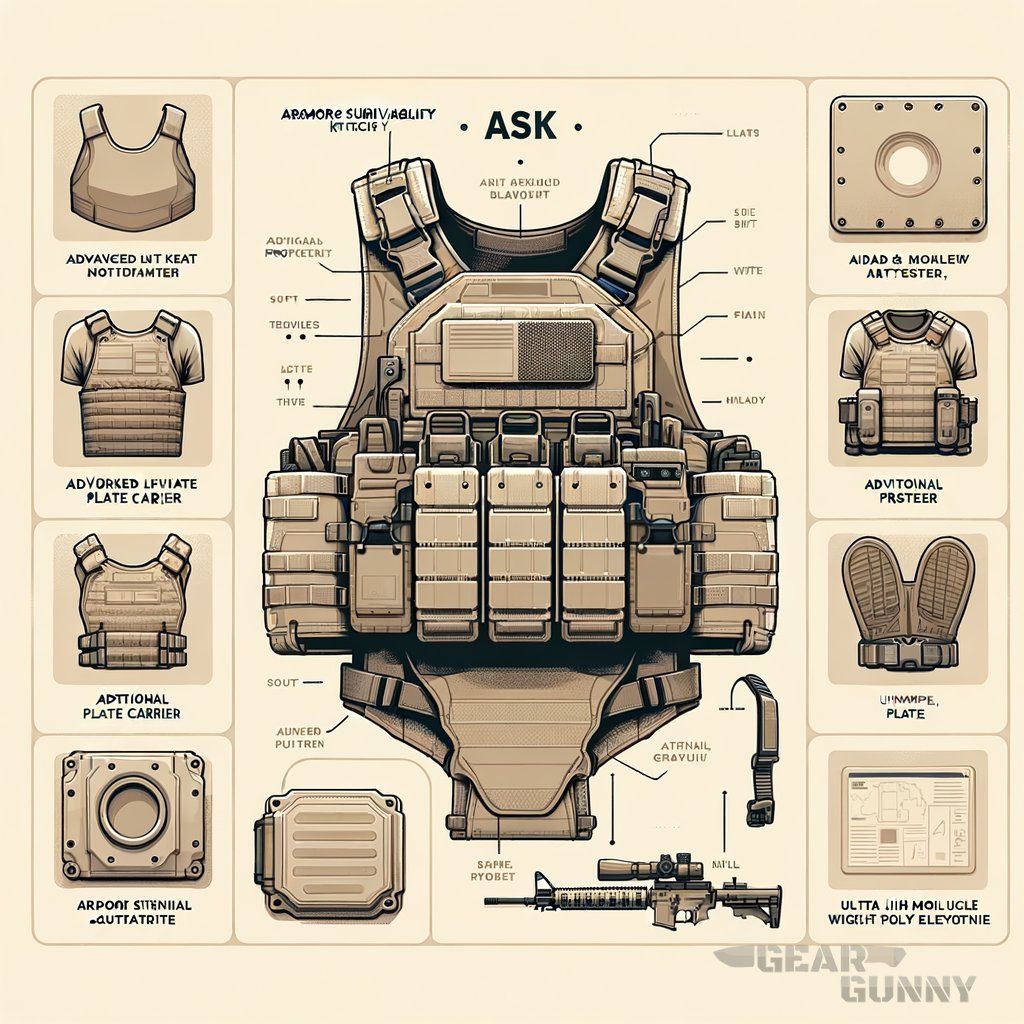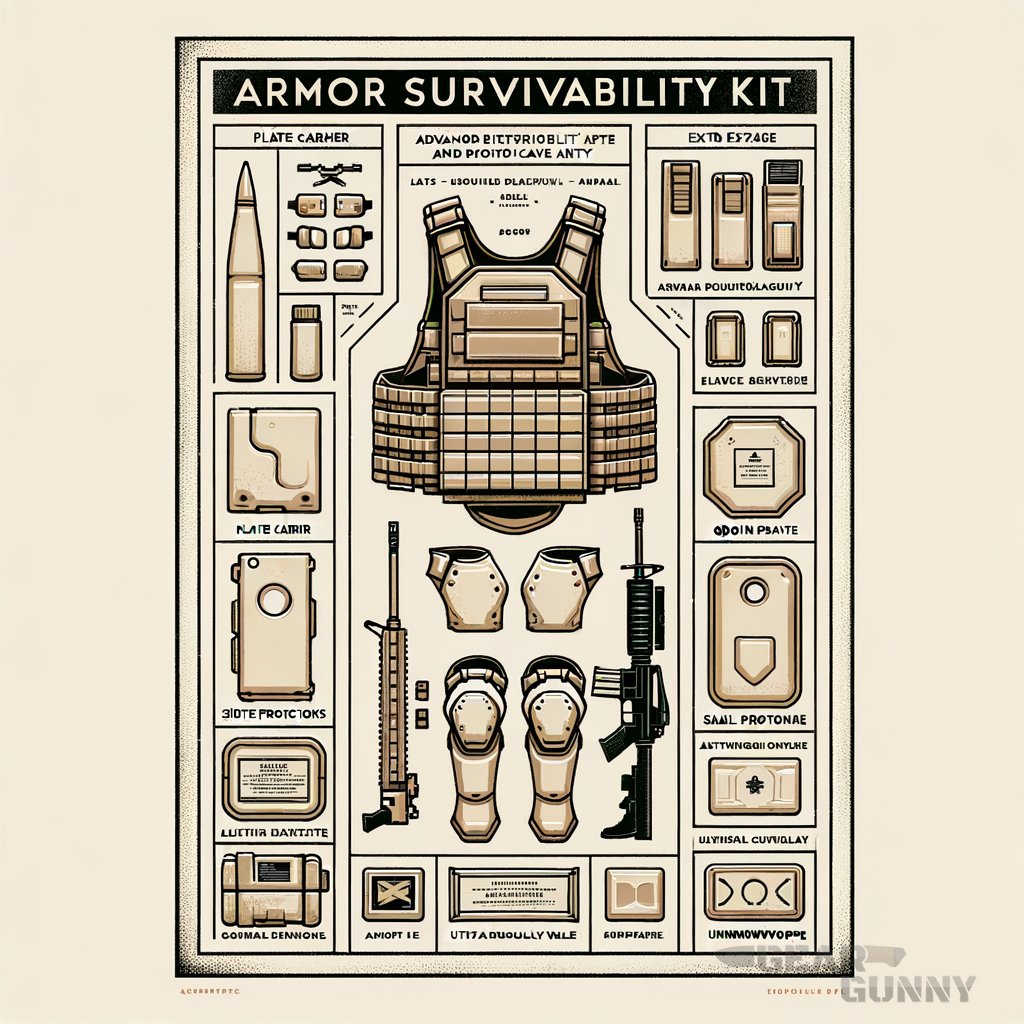
Ever wondered about the gear keeping our troops safe under heavy fire? **What exactly goes into an Armor Survivability Kit**? It's the backbone of **military protective equipment**. In this post, you'll deepen your understanding of these kits and why they're critical in the field. Check out some of the top-notch **plate carriers** for a better grasp on tactical gear essentials. ## What is an ASK kit? (Armor Survivability Kit) An ASK kit, or Armor Survivability Kit, ups the ante in battlefield protection. It’s tailored to reduce the impact of direct hits on our service members by enhancing existing armor. Think of it as an upgrade package for a warfighter's personal armor system; improving its resistance to various threats and adding pivotal protective elements without sacrificing mobility. Here's a quick breakdown of what you'll typically find in an ASK kit: * Advanced plate carriers designed to distribute weight more effectively and allow greater flexibility. * More side and groin protectors beefing up coverage where standard armor might fall short. * Cutting-edge materials used in plate construction, such as UHMWPE (Ultra High Molecular Weight Polyethylene), which boast high durability yet remain surprisingly light. With varying configurations based on mission requirements, these kits play a pivotal role in keeping our troops **"on target"** when they're in harm's way. For an in-depth look at the materials crucial to armor performance, discover the essentials about [ballistic materials in armor](https://geargunny.com/equipment-and-supplies/what-are-ballistic-materials-in-armor). In my opinion, as someone who's no expert but has a vested interest in military tech, an ASK kit isn't just equipment; it's a lifeline for our service members. While I may not be able to dive into the technical aspects with the finesse of an engineer, the value of these kits isn't lost on me. Decent gear can make the difference between a close call and a call home. There was this time in the corps when a buddy of mine credited his ASK with saving his bacon during a surprise ambush. It's moments like these that underscore the sheer importance of top-tier gear like the ASK. It's almost like that famous scene in the movie "Black Hawk Down" where the plate carriers take center stage, showcasing the gravity of having reliable body armor in life-or-death situations. You'll want to keep your eyes peeled for the best the market has to offer, like these [tactical gloves](https://geargunny.com/equipment-and-supplies/best-tactical-gloves/) that pair well with an ASK for full combat readiness.
## Key components of an ASK kit ### What's included in an ASK kit? An Armor Survivability Kit is geared to enhance the soldier's protection. **Essential components of an ASK kit include**: * Modular plate carriers for improved fit and adaptability * More body armor plates for side, shoulder, and groin protection * Accessories such as throat guards and ballistic eye protection for comprehensive coverage These components not only offer more robust protection but also allow for agility and a range of motion. For more details on the flexibility and security balance, explore these [tactical belts](https://geargunny.com/equipment-and-supplies/best-tactical-belts/) that serve a similar purpose in a soldier's loadout. ### How do ASK kits improve survivability? It’s all in the design and materials. ASK kits use advanced construction techniques and materials like ceramic composite and UHMWPE. This means soldiers can withstand higher-caliber rounds and shrapnel impacts more effectively. Enhanced protection on the battlefield translates to higher survival rates, making these kits indispensable. Get the scoop on the importance of **armor testing backface signature** to see how gear is rigorously examined for ultimate protection. ## Understanding the use of ASK kits ### In what situations are ASK kits most beneficial? ASK kits shine in hostile environments where threats are unpredictable. They're most beneficial during: * Direct combat operations where heavy fire is expected * Missions in urban settings with the potential for close-quarter encounters The modular nature of ASK kits allows soldiers to tailor their armor for the mission at hand, keeping them light on their feet or heavily guarded as the situation demands. Brush up on the military's strategic formations like [what is a battery in military artillery](https://geargunny.com/training-and-tactics/what-is-a-battery-in-military-artillery) to understand how ASK kits fit into larger tactical operations. ### Who typically uses ASK kits? Primarily, frontline combat troops and special operations forces use ASK kits. These warriors face the highest risk and thus need the highest level of protection. Whether it's a Marine squad in a firefight or a Navy SEAL team on a covert mission, these kits are critical for survival. Dive into the culture and terminology with a look at [what BAMCIS stands for in the Marine Corps](https://geargunny.com/training-and-tactics/what-does-bamcis-stand-for-in-the-marine-corps) to appreciate the planning that goes into utilizing such gear effectively. ## Maintaining and upgrading ASK kits ### How are ASK kits maintained? Maintaining an ASK kit requires diligence. **Regular checks and care routines are key**. Soldiers inspect their kits for: * Wear and tear on the carrier components * Damage to the plates or any protective elements * Proper fit adjustments for comfort and effectiveness Routine maintenance is critical to ensure the gear functions as intended when it's needed most. Learn about materials like [barnyard acid-resistant leather](https://geargunny.com/equipment-and-supplies/what-is-barnyard-acid-resistant-leather) that contribute to the durability of military-related equipment. ### Can ASK kits be upgraded? Yes, the modular design facilitates easy upgrades. Soldiers can integrate newer armor plates and more protective accessories as they become available. Upgrades can focus on enhancing protection or reducing weight for increased mobility. To complement these mods, consider the support provided by robust [tactical boots](https://geargunny.com/equipment-and-supplies/best-tactical-boots/) that keep soldiers mobile and comfortable on the move.
Before diving into the specifics of an ASK kit, here's a table that lays out the standard elements you'd find in such a kit. Understanding the components can help illustrate the importance and intricacies of military protective equipment. | Component | Function | Material Type | |---------------------------|--------------------------------------------------------------------------|------------------------------------| | Plate Carrier | Distributes weight of plates; houses gear | Nylon, Cordura, or other synthetics| | Body Armor Plates | Protect vital organs from ballistic threats | Ceramic, Steel, UHMWPE | | Side Plate Pockets | Adds protection on the flanks | Similar to plate carrier materials | | Groin Protector | Defends against lower torso injuries | Kevlar, Laminated synthetic fibers | | Shoulder Pads | Provides cushioning and extends coverage upwards | Foam padding, Synthetic fibers | | Throat Guard | Shields neck area from projectiles | Kevlar, Ballistic nylon | | Ballistic Eyewear | Offers eye protection from dust, debris, and small projectile penetrations| Polycarbonate, Ballistic glass | Captions: A snapshot of standard Armor Survivability Kit components, their roles in soldier protection, and the materials from which they are crafted.
## More armor kit customization tips Properly outfitting yourself with an ASK kit can mean the difference between a good day and a bad one in the field. Here are some extra pointers to ensure you're fully squared away: * Evaluate and adjust your kit regularly to account for any changes in your mission profile or body size. * Work with a buddy to check hard-to-see places like your back for proper plate placement and fit. * Train with your full gear on to get accustomed to its weight and feel, which will improve your agility and comfort in the field. * Invest in hydration systems that integrate with your kit to maintain peak performance during prolonged operations. * Consider the climate you'll be operating in and choose undergarments that will wick moisture away and help regulate body temperature. Following the right approach when customizing and maintaining your armor can greatly enhance your effectiveness. Below you'll find a list of key dos and don'ts to keep in mind: | Do | Don't | |----------------------------------------|-------------------------------------------| | Regularly inspect your gear for damage | Overload your kit with unnecessary gear | | Test the fit after any adjustments | Ignore discomfort as it can mean a poor fit| | Keep your kit clean and dry | Neglect to learn about your kit's materials| | Store your gear properly when not in use| Use damaged or expired armor plates | A guide to smart practices for maintaining and customizing your Armor Survivability Kit (ASK). ## Advantages and disadvantages of ASK kits When talking about ASK kits, it's not only the features that count but also how they stack up in real-world applications. Let's dive into the strengths and weaknesses. ### Advantages Here's why ASK kits are a vital piece of gear in a soldier's arsenal: * Enhanced ballistic protection against a range of threats * Modular design allows for customization to fit the mission profile * Use of lightweight materials reduces wearer fatigue * Scalability to add or remove components as needed * Upgradable to incorporate the latest protective technology ### Disadvantages On the flip side, there are some limitations you need to consider: * More weight may impact mobility and stamina * Heat retention can be a factor, potentially leading to overheating * Cost can be prohibitive for some units or people * Requires regular maintenance to ensure protective quality * Complex systems may require more training to use effectively
> **"An ASK kit isn't just equipment; it's a lifeline for our service members. Decent gear can make the difference between a close call and a call home."** This underscores the gravity of having reliable body armor in life-or-death situations and the importance of continuous improvements in protective technology.
### Frequently asked questions (FAQ) ### How usually should ASK kits be replaced? The lifespan of an ASK kit varies based on usage and exposure to elements, but it's generally recommended to replace armor plates every 5 years or after they've sustained a hit. Regular inspection and maintenance can help identify when components need replacement. ### Can ASK kits be used by civilians? While ASK kits are primarily designed for military use, there are civilian versions available for personal protection. These are particularly popular among journalists, aid workers in conflict zones, and those involved in high-risk security jobs. ### Are there any restrictions on traveling with ASK kits? Travel restrictions for ASK kits depend on local laws and the airline's policies. Generally, it's prohibited to travel with body armor in carry-on luggage, but it can usually be transported in checked baggage. Always check regulations before travel to avoid complications.
### Final thoughts We've marched through the nuts and bolts of the Armor Survivability Kit, dissecting its components, uses, and the delicate balance between protection and mobility. It's clear that ASK kits are more than just a means of defense—they represent a commitment to soldier safety and tactical adaptability. As technology marches forward, so too will the sophistication and effectiveness of these kits. **How does the idea of such advanced gear impact your view on modern warfare? Did I cover everything you wanted to know?** *Let me know in the comments section below; **I read and reply to every comment**. If you found this article helpful, share it with a friend, and check out my full blog for more tips and tricks on tactical gear and survival techniques. Thanks for reading and stay sharp out there.* <p>Key takeaways</p> <ul> <li><b>ASK kits significantly enhance a soldier's survivability</b> by adding advanced protection and modular components.</li> <li>These kits are <b>upgradable and customizable</b>, fitting a variety of operational scenarios.</li> <li><b>Maintenance and care</b> are crucial for ensuring ASK kits function effectively when it counts.</li> </ul>
If you are a visual learner, check out this video titled ‘How to set up your body armor | Special Forces Techniques | Tactical Rifleman’

















